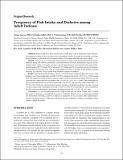| dc.description.abstract | Objectives: Recent studies have shown that the choice of foods plays a role in diabetes prevention. However, little empirical evidence on this association exists in developing countries. We aimed to examine the association between frequency of fish intake and self-reported diabetes status among adult men and women in India. Methods: Analysis of cross-sectional data from participants in India's third National Family Health Survey conducted during 2005–2006 was performed. Associations between fish intake, determined by frequency of consumption (daily, weekly, occasionally, and never), and self-reported diabetes were estimated using multivariable-adjusted models in 99,574 women, 56,742 men, and 39,257 couples aged 20–49 years after adjusting for frequency of consumption of other food items, body mass index (BMI) status, tobacco smoking, alcohol drinking, watching television, age, education, living standard of the household, and place of residence. Results: After adjustment for other dietary, lifestyle, and socioeconomic and demographic characteristics, odds of diabetes were 2 times higher (odds ratio [OR]: 2.02; 95% confidence interval [CI], 1.59–2.57; p < 0.0001) among those who reported consuming fish daily compared to those who never consumed fish. Weekly fish intake was also associated with a higher odds of having diabetes (OR: 1.55; 95% CI, 1.25–1.93; p < 0.0001). The adjusted effect of daily fish intake on diabetes was greater among men (OR: 2.46; 95% CI, 1.66–3.65) than among women (OR: 1.72; 95% CI, 1.26–2.33). In cross-spousal sensitivity analysis, the odds of a husband having diabetes was also associated with wife's daily/weekly consumption of fish (OR: 1.36; 95% CI, 0.92–2.01) and the odds of a wife having diabetes was also associated with husband's daily/weekly consumption of fish (OR: 1.21; 95% CI, 0.87–1.68). Conclusions: In a large nationally representative sample of adult men and women in India, daily or weekly fish intake was positively associated with the presence of diabetes. However, this is an observational finding and uncontrolled confounding cannot be excluded as an explanation for the association. More epidemiological research with better measures of food intake and clinical measures of diabetes is needed in a developing country setting to validate the findings. | en |


